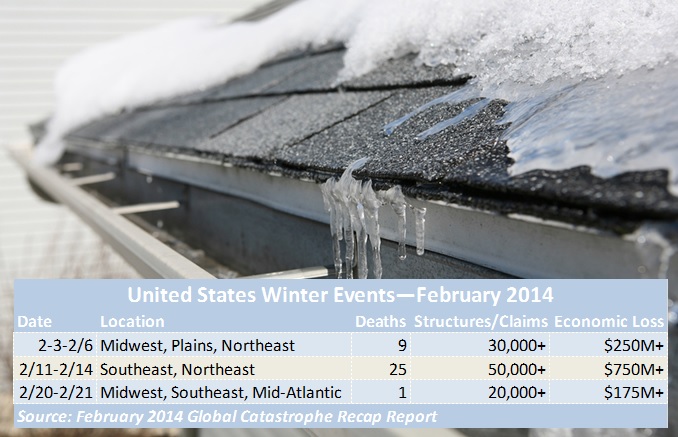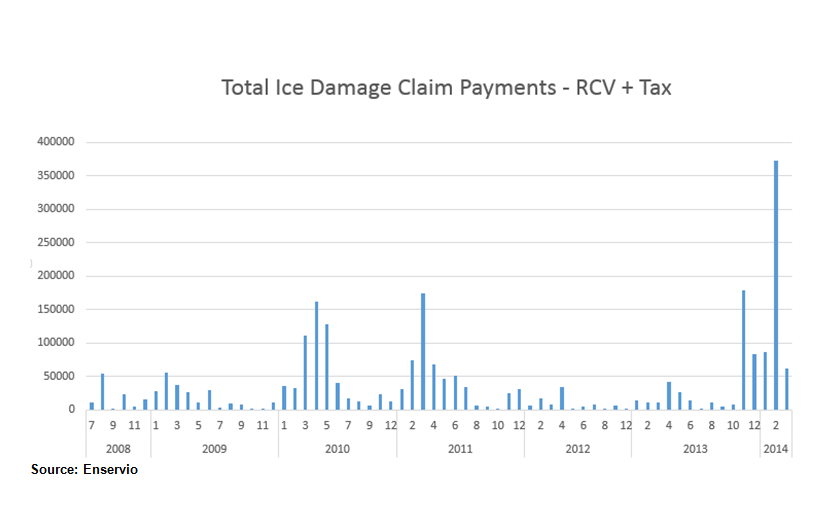The winter of 2014 looks to go down in history for record temps and record claims. To date, Enservio data shows that in February 2014 alone, ice damage related RCV jumped 200% over the last five winters.
February storms resulted in payouts of more than $1 billion in insured losses globally, according to Aon Benfield’s February 2014 Global Catastrophe Recap Report. The United States wasn’t the only country caught frozen. Japan was the country struck hardest with record snowfall resulting in 37 deaths and 2,750 injuries.
Here at home, three winter storms were responsible for 35 deaths, more than 100,000 structural claims and economic losses in excess of $1 billion in February, according to Aon Benfield’s report.
From ice dams to frozen pipes, the polar vortex wreaked havoc on people, structures and insurance loss ratios.
Enservio data below illustrates how much U.S. insurers paid out in ice damage claims over the past six years. The towering bar in February 2014 is ominous enough to send chills down the spines of the most veteran claims adjusters. Of particular note is that February 2014 has seen an increase in ice damage related replacement cost value of 200 percent over any month in the past five winters.
Also noteworthy are these statistics from the National Climatic Data Center:
- Persistent cold caused 91 percent of the Great Lakes to be frozen by early March, the second largest ice cover on record.
- Wisconsin had a top-10 cold winter and Detroit had its snowiest winter on record.
- According to NOAA data analyzed by the Rutgers Global Snow Lab, the February snow cover extent for the contiguous United States was 1.48 million square miles, 282,000 square miles above the 1981-2010 average. This was the ninth largest February snow cover extent in the 48-year period of record for the contiguous U.S. and the largest since 2010.
- The contiguous U.S. February temperature was 32.2 degrees Fahrenheit, 1.6 degrees below the 20th century average, and the 37th coldest February on record.
No vanilla ice here
There was nothing vanilla about the ice and snow of this winter. And, we’re not moving on to sunny skies quite yet. In 2013, the United States experienced four major storms in April. If the past is any indicator of the present, the ice may not be thawing anytime soon. When that inevitability occurs, we may be looking at record-breaking flooding next.
Beyond everyday preparation tips like insulating pipes and raking your roof, onsite claims professionals can help protect the policyholder from claims down the road by taking care not to overlook other collateral damage. For example, something as minor as a torn shingle can lead to a water-damaged attic in the coming months of what will hopefully be warmer temperatures and associated thaw.






















 Survey: Majority of CA/FL Homeowners See Rise in Insurance Costs, Coverage Changes
Survey: Majority of CA/FL Homeowners See Rise in Insurance Costs, Coverage Changes  Ford Recall of 43,000 SUVs Due to Fire Risk Won’t Remedy Gas Leaks
Ford Recall of 43,000 SUVs Due to Fire Risk Won’t Remedy Gas Leaks  USAA to Lay Off 220 Employees
USAA to Lay Off 220 Employees  That Insurance Talent Crisis? It’s a Global Knowledge Opportunity
That Insurance Talent Crisis? It’s a Global Knowledge Opportunity 






